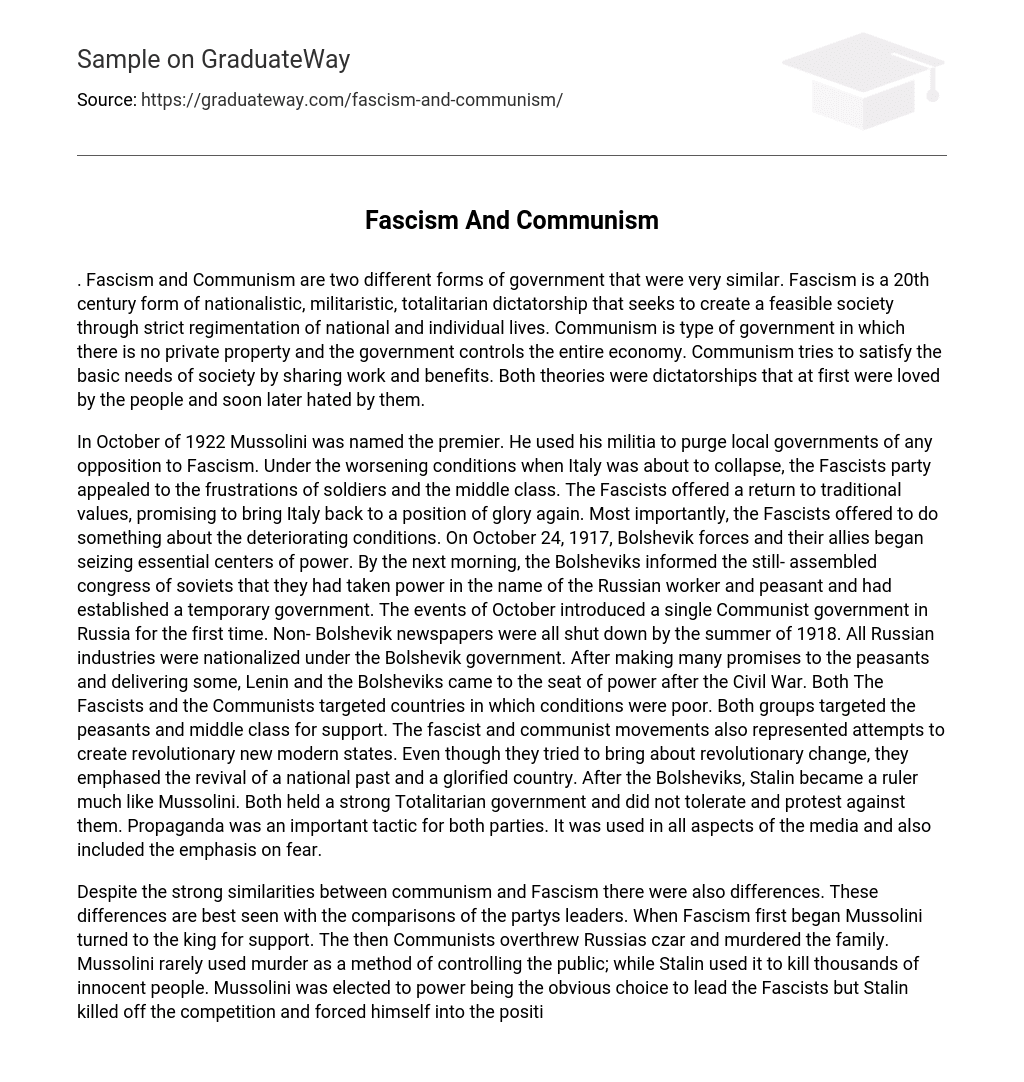Fascism and Communism are two distinct forms of government that have many similarities. Fascism, which emerged in the 20th century, is characterized by nationalism, militarism, and a totalitarian dictatorship. Its goal is to establish a society through strict control over both the nation and individuals. In contrast, Communism is a governmental system where private property does not exist and the state exercises complete authority over the economy. To fulfill society’s basic needs, Communism advocates for the sharing of labor and benefits among its citizens. Despite their differences, both ideologies initially gained widespread support but eventually lost popularity with the people.
In October of 1922, Mussolini became the premier, utilizing his militia to remove any opposition to Fascism from local governments. The Fascist party capitalized on the worsening conditions in Italy and appealed to frustrated soldiers and the middle class. They promised a return to traditional values and restoring Italy’s former glory. Additionally, the Fascists offered solutions to the deteriorating conditions. On October 24, 1917, Bolshevik forces and their allies initiated the seizure of essential centers of power. The next day, the Bolsheviks informed the assembled congress of soviets that they had taken power in the name of the Russian worker and peasant and established a temporary government. This marked the first instance of a single Communist government in Russia. By summer 1918, all non-Bolshevik newspapers were shut down, and Russian industries were nationalized under Bolshevik rule. After fulfilling some promises made to peasants, Lenin and the Bolsheviks gained power following the Civil War. Both the Fascists and Communists targeted countries with poor conditions and sought support from peasants and the middle class. These movements aimed to create revolutionary modern states.Despite their attempts to bring about a revolutionary transformation, they focused on reviving their nation’s history and exalting their country. Following the Bolsheviks, Stalin and Mussolini assumed similar roles as rulers, leading strong totalitarian governments and showing no tolerance for dissent or opposition. Propaganda played a crucial role for both regimes, effectively permeating all forms of media and instilling fear as a key component.
Although communism and Fascism had many similarities, they also had differences in terms of their leaders. In the case of Fascism, Mussolini sought support from the king when it first began. Conversely, the Communists overthrew Russia’s czar and executed the entire royal family. Mussolini rarely resorted to murder as a means of controlling the public, unlike Stalin who killed thousands of innocent people and used it as a tool for control. Additionally, while Mussolini was elected to power as the obvious choice to lead the Fascists, Stalin eliminated his competition and forcefully assumed the position of dictator.
Although Communists and Fascists both focused on internal affairs, they were influenced by external factors. Their main goal was to establish their nations as the most powerful. Both leaders acknowledged and utilized the influence of others in their governance. For example, Stalin greatly admired Mussolini and drew inspiration from him. In a dictatorship, ordinary citizens have no authority or control over decisions that affect their lives. Instead of serving the people, the government becomes a tool for the ruling elite. While Communism and Fascism initially thrived in Russia and Italy, they eventually succumbed to the dominance of Capitalism.





